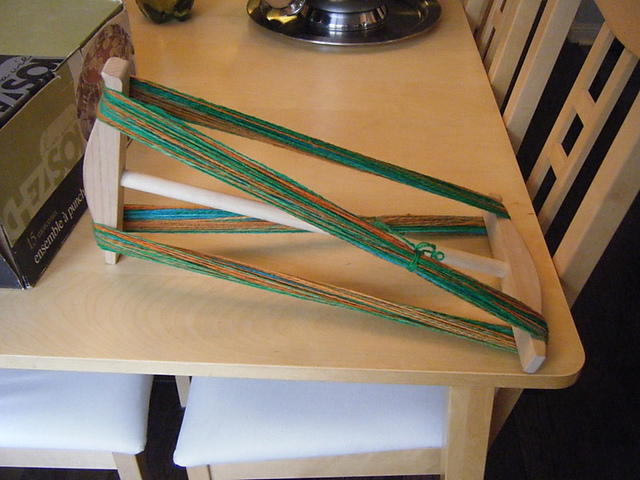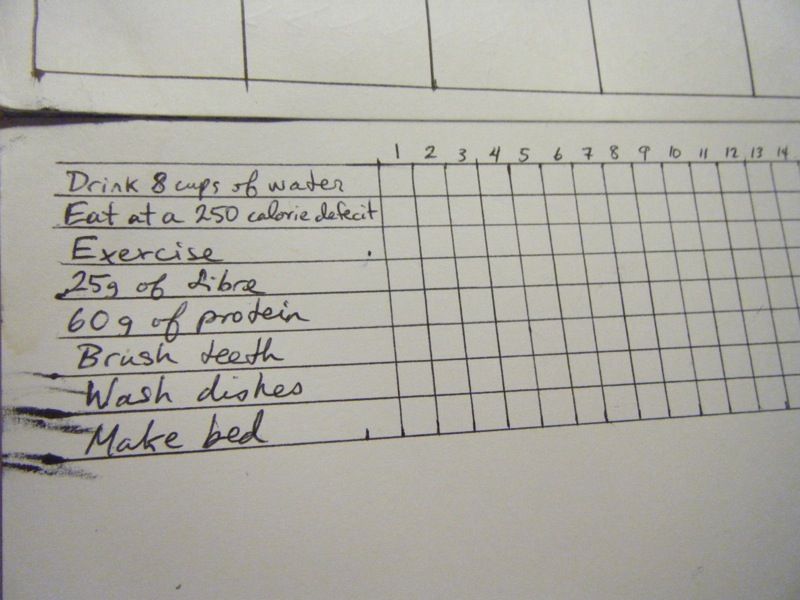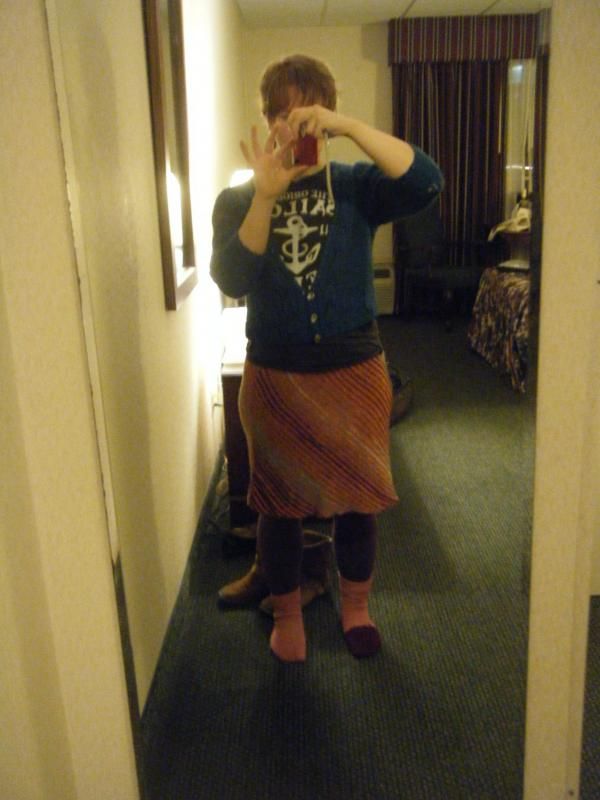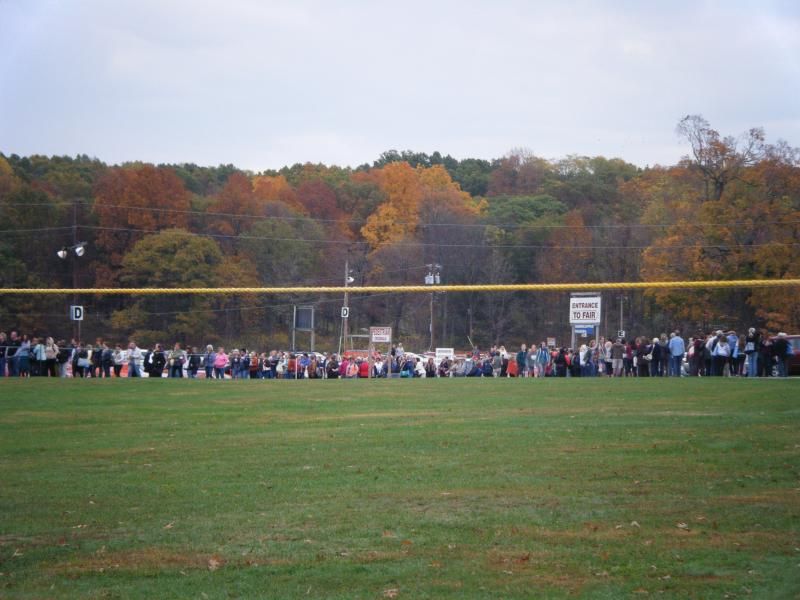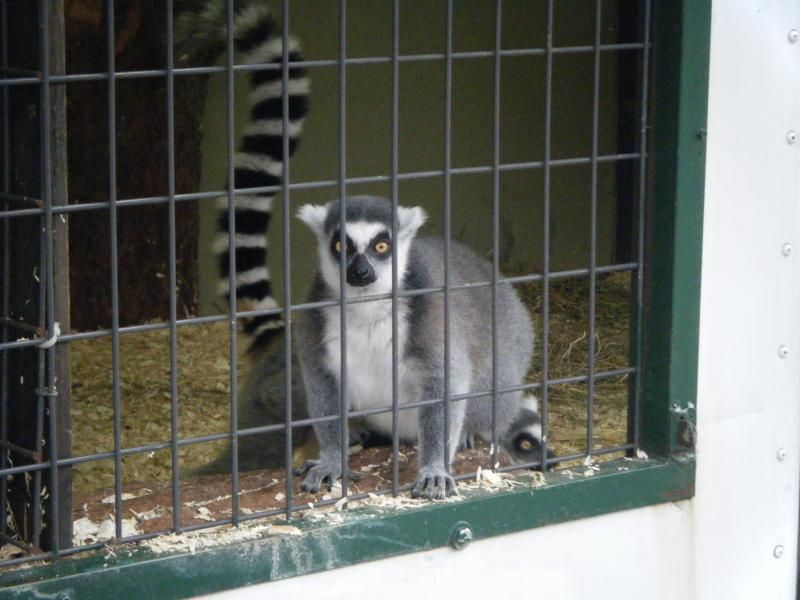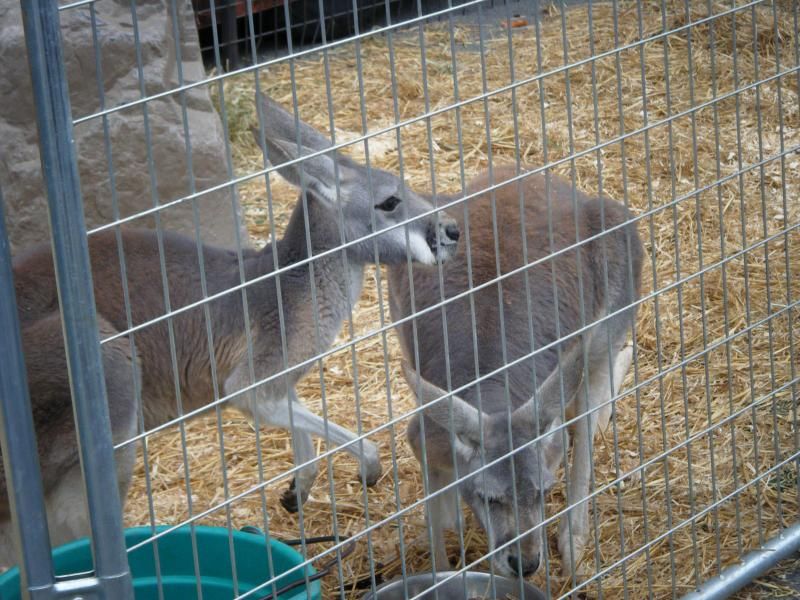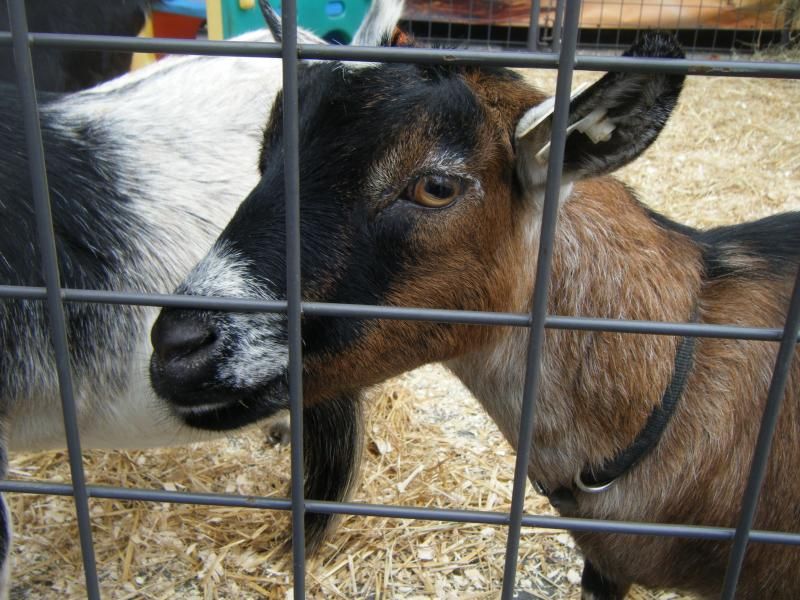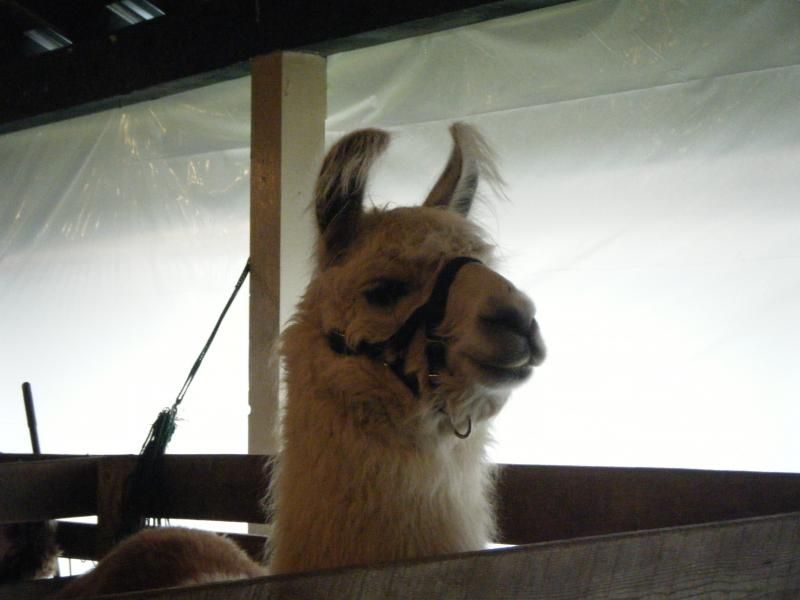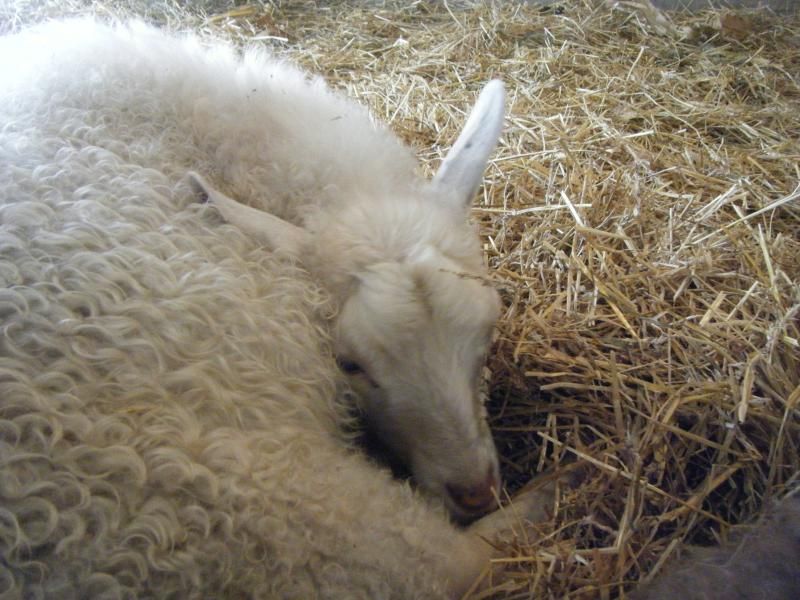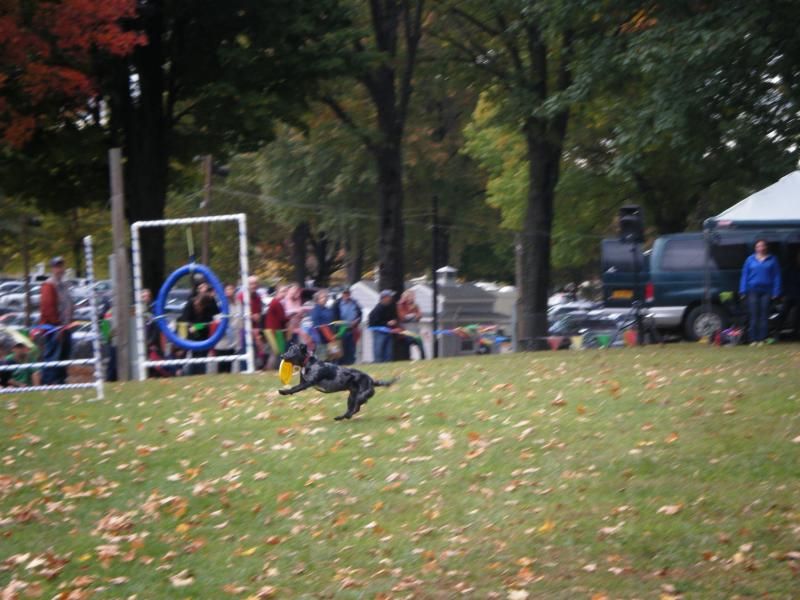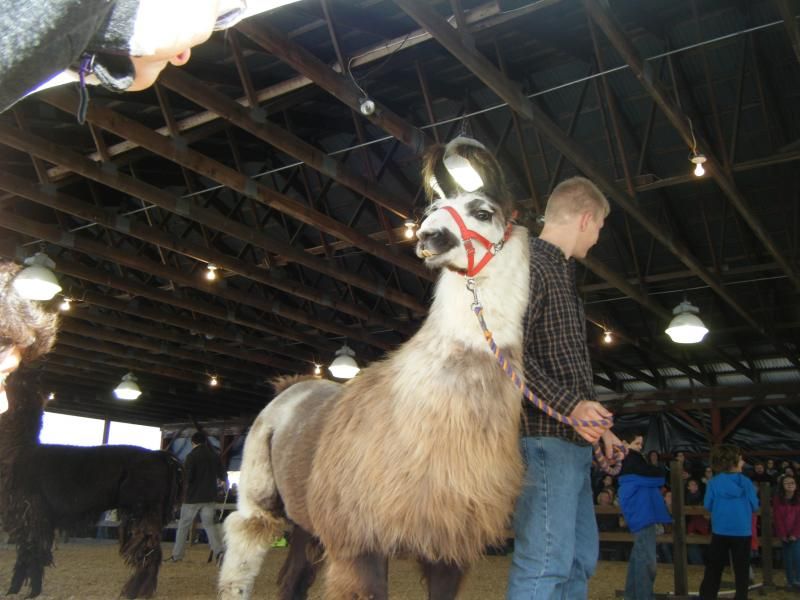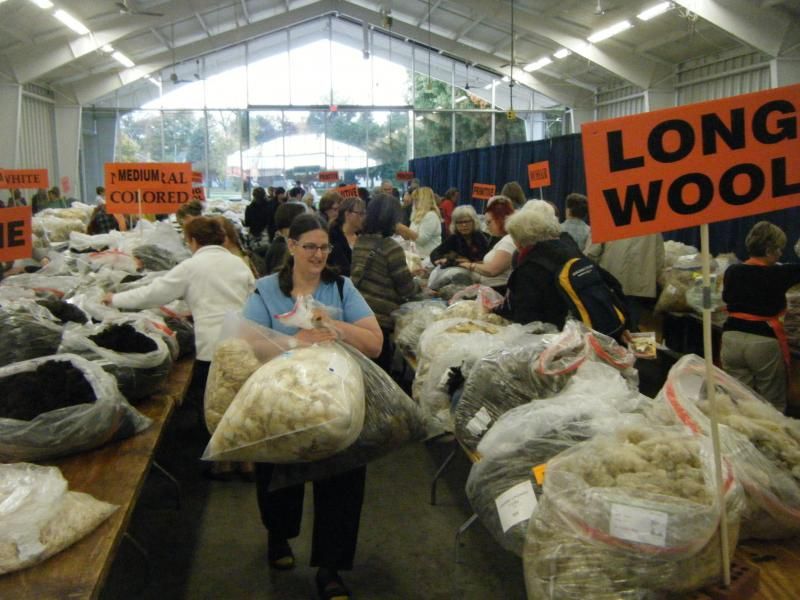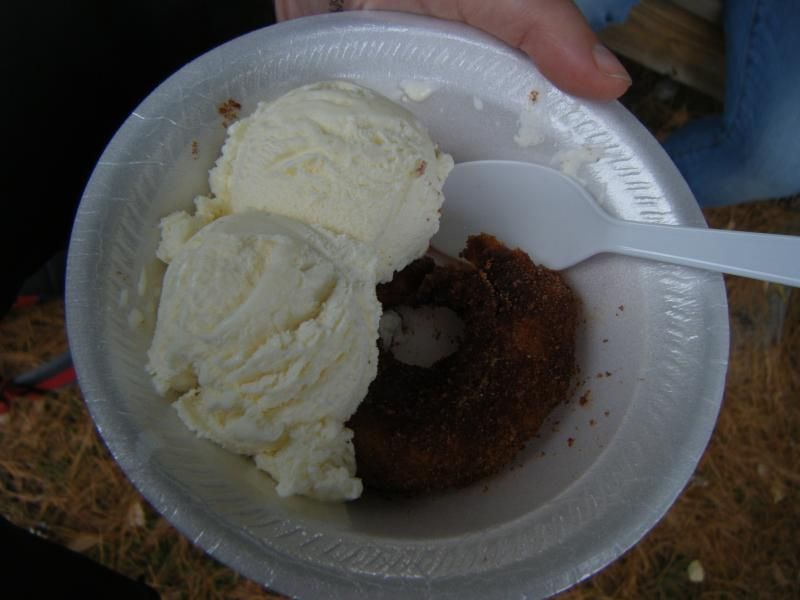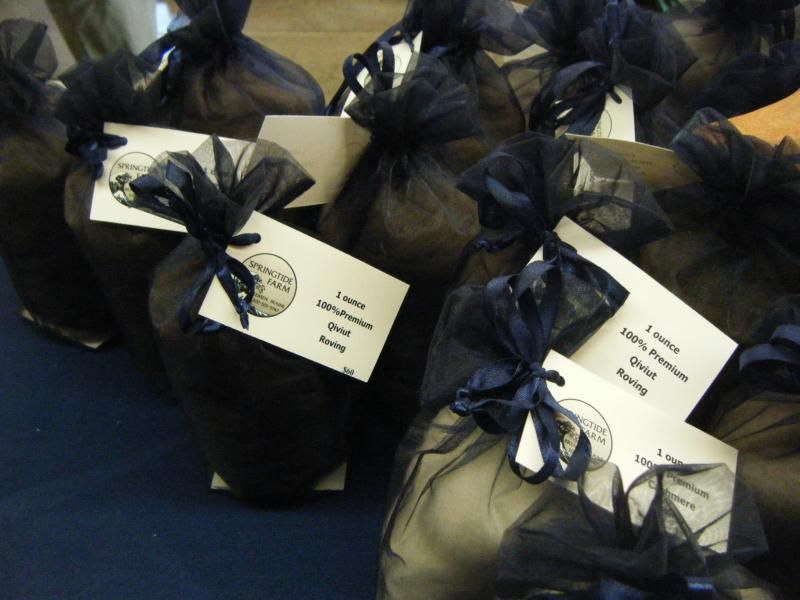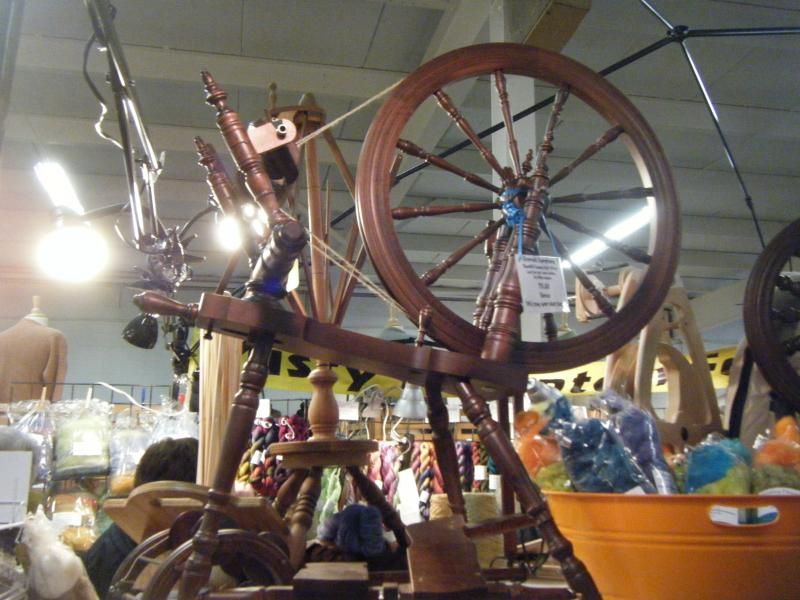Gosh I've knit a lot of things for babies over the years! I count 26 projects recorded on Ravelry, and I think there are probably a few that I never got around to recording on there. My favourite baby projects are always the cute little stuffies. There's just something magical about putting together a little creature and watching it come to life with its own unique personality. Some old favourites are the oh-so-clever duck-bunny, my grandmother's puppy, and Octie the Octopus (get the pattern here!).
My most recent creation was for my little one-year-old niece from Switzerland. For her first half-birthday, I had given her what the boyfriend affectionately calls the "Pants Monster", but would more accurately be called Kevin the Unibody Monster from the Monster Mobile pattern by Rebecca Danger from her book Knit a Monster Nursery. Here's what the original version I gave her looked like (or at least very similar to that, since that's a version I made for another baby):
Notice the long arms, light-weight yarn (DK in this case), small body size... The original pattern, which was only one of many monsters included on the mobile, was in fingering weight yarn, and made for quite a small monster. Well, the first monster got lost on a skiing trip, and so my sister-in-law sheepishly requested a replacement, since my niece had liked playing with it so much. And without further ado, here's Pants Monster Number Two!
He looks a little caught off-guard here, but what he's really doing is admiring my collection of physics, math, and astronomy books. He's quite an intelligent little fellow!
His personality, however, has more than one facet! He's also quite computer savvy:
He's strong, and likes doing weights:
But also sensitive, and sad about how cold it is outside...
Pants Monster #2 was knit in Bernat Softee Chunky Solid, hence the much larger size. The face was made from felt and sewed on with sewing thread. I'm really really really happy with how he turned out, and I'll admit that it was a bit of a challenge saying goodbye! Fortunately, my niece loved him, which makes his departure a little easier.
Off the Hook Astronomy
Crochet, knitting, astronomy & life in general.
Saturday, February 21, 2015
Sunday, January 11, 2015
The Autumn Leaves cardigan
Carl Sagan once said, "If you wish to make an apple pie from scratch, you must first invent the Universe." I felt a little like I'd just invented the Universe with my most recently finished sweater. Two years in the making, the roving from which the yarn was made was dyed a couple of summers ago, the yarn was spun on a drop spindle over the course of those two years, and then the whole sweater was knit in less than a week.
In the beginning, there was the dying:
As I wrote in a previous blog post (unfortunately, all of the image links are broken), this roving was dyed with acid dies in the summer of 2012 during a very fun afternoon with Joanna. This is what the roving looked like after it was dry and all nicely braided up:
I spun the whole lot (I'll admit that I never weighed the whole mess, so I'm not entirely sure how much there was) on my cut acrylic drop spindle from Seven Yaks Design. I chain plied it so that it would be a 3-ply yarn with a roughly DK to light worsted weight. Of course, it was closer to fingering in some spots and aran in others, but I think the average thickness was about DK. Here's some of it on a niddy-noddy:
From how many times each skein wrapped around the niddy-noddy, I estimated that I spun approximately 588 yards of the stuff. Here it is drying after I washed all the yarn:
And finally, here's the sweater!
I loosely followed the Ruby Tuesday pattern by Ewa Durasiewicz, a round-yoke top-down design, but because I didn't get the same gauge with my handspun as called for in the pattern, I didn't do the third set of increases. Somehow, I managed to do the right calculations and end up with a sweater that fits me perfectly. The buttons don't match, but I kind of like it that way. Best part: I used up all the yarn!
As a first experience knitting with hand-spun yarn, I've gotta say, it's pretty amazing. The knitting experience felt so natural and organic, it was like nothing else. I would recommend it to anyone. I can hardly wait to finish spinning up my next batch of yarn to knit with!
In the beginning, there was the dying:
As I wrote in a previous blog post (unfortunately, all of the image links are broken), this roving was dyed with acid dies in the summer of 2012 during a very fun afternoon with Joanna. This is what the roving looked like after it was dry and all nicely braided up:
I spun the whole lot (I'll admit that I never weighed the whole mess, so I'm not entirely sure how much there was) on my cut acrylic drop spindle from Seven Yaks Design. I chain plied it so that it would be a 3-ply yarn with a roughly DK to light worsted weight. Of course, it was closer to fingering in some spots and aran in others, but I think the average thickness was about DK. Here's some of it on a niddy-noddy:
From how many times each skein wrapped around the niddy-noddy, I estimated that I spun approximately 588 yards of the stuff. Here it is drying after I washed all the yarn:
And finally, here's the sweater!
I loosely followed the Ruby Tuesday pattern by Ewa Durasiewicz, a round-yoke top-down design, but because I didn't get the same gauge with my handspun as called for in the pattern, I didn't do the third set of increases. Somehow, I managed to do the right calculations and end up with a sweater that fits me perfectly. The buttons don't match, but I kind of like it that way. Best part: I used up all the yarn!
As a first experience knitting with hand-spun yarn, I've gotta say, it's pretty amazing. The knitting experience felt so natural and organic, it was like nothing else. I would recommend it to anyone. I can hardly wait to finish spinning up my next batch of yarn to knit with!
Monday, December 22, 2014
Why I'm a bad blogger: catching up on last year's X-mas Knitting
Yes. I'm terrible at writing blog posts about my knitting in a timely manner. We all know that. Now, as I'm in the throes of my 2014 X-mas knitting, let's take a look at what hand-made goodies I made for my family last year!
X-mas 2013 was all about the socks. My dad was the lucky recipient of the Guitar Man Socks, a lovely pattern designed by Rebecca Mercier. They were an easy, almost-mindless knit, but with enough complexity in the pattern to prevent it from getting boring. The yarn I used was Knit Picks Stroll Tweed in the colourway Autumn Heather. Let me say it now: if you haven't yet knit with this yarn, it's an absolute must. It's lovely and soft and the little flecks are so pretty! Highly recommended.
For my little brother, I knit the Vihtory socks by Heli Heikkilä, also a very lovely pattern. One word of warning, if you're a fan of the two-at-a-time magic loop technique for socks: after knitting the foot of the sock, where the cables are only on the top of the foot, and turning the heel, the cables go all the way around, which is impossible to work two at a time. I switched to knitting the socks separately at this point. The yarn used is Diamond Luxury Collection Soxy (unfortunately discontinued) in the aptly named Charcoal Space Dyed colourway. I picked up this yarn during my trip to Victoria, BC several years ago where I visited the Beehive Wool Shop.
I'll admit to having gone a little insane with all the sock knitting last X-mas, especially since the men in my life have such large feet. The largest-footed of all is the boyfriend, whose shoe size comes in at a whopping 12 men's. I'll also admit that these socks didn't actually get finished until mid-February. They were, however, meant as an X-mas gift, so I'm still counting them. They are just plain stockinette socks with the snail added on with duplicate stitch, using this chart. I again used Stroll Tweed in the Wellies Heather colourway, which made the knitting bearable. And they were a huge success! The boyfriend has declared these his favourite socks. I call that a win.
Now, I had also knit socks for my friend Ed using the Lucky Stripes pattern by Tofutrulla, an interesting striped sock pattern which gets you to roll a die to determine how many rows of each colour to knit between colour changes. I did not, however, get pictures of them, since I was knitting the last few rows and binding off moments before they were gifted.
The final bit of X-mas knitting was not socks, but instead a hat for my cousin. I used the Declan's Hat pattern by Samantha Kirby, which was absolutely lovely. It starts off easily, and just as that ribbing starts to get boring, the crown is all fun and cabley. I've knit this pattern for myself since. The yarn is good old Cascade 220 in Light Grey which I had left over from another project.
And that's it for my 2013 X-mas knitting! Hopefully the projects currently in progress will take less than 12 months to show up on the blog!
X-mas 2013 was all about the socks. My dad was the lucky recipient of the Guitar Man Socks, a lovely pattern designed by Rebecca Mercier. They were an easy, almost-mindless knit, but with enough complexity in the pattern to prevent it from getting boring. The yarn I used was Knit Picks Stroll Tweed in the colourway Autumn Heather. Let me say it now: if you haven't yet knit with this yarn, it's an absolute must. It's lovely and soft and the little flecks are so pretty! Highly recommended.
For my little brother, I knit the Vihtory socks by Heli Heikkilä, also a very lovely pattern. One word of warning, if you're a fan of the two-at-a-time magic loop technique for socks: after knitting the foot of the sock, where the cables are only on the top of the foot, and turning the heel, the cables go all the way around, which is impossible to work two at a time. I switched to knitting the socks separately at this point. The yarn used is Diamond Luxury Collection Soxy (unfortunately discontinued) in the aptly named Charcoal Space Dyed colourway. I picked up this yarn during my trip to Victoria, BC several years ago where I visited the Beehive Wool Shop.
I'll admit to having gone a little insane with all the sock knitting last X-mas, especially since the men in my life have such large feet. The largest-footed of all is the boyfriend, whose shoe size comes in at a whopping 12 men's. I'll also admit that these socks didn't actually get finished until mid-February. They were, however, meant as an X-mas gift, so I'm still counting them. They are just plain stockinette socks with the snail added on with duplicate stitch, using this chart. I again used Stroll Tweed in the Wellies Heather colourway, which made the knitting bearable. And they were a huge success! The boyfriend has declared these his favourite socks. I call that a win.
Now, I had also knit socks for my friend Ed using the Lucky Stripes pattern by Tofutrulla, an interesting striped sock pattern which gets you to roll a die to determine how many rows of each colour to knit between colour changes. I did not, however, get pictures of them, since I was knitting the last few rows and binding off moments before they were gifted.
The final bit of X-mas knitting was not socks, but instead a hat for my cousin. I used the Declan's Hat pattern by Samantha Kirby, which was absolutely lovely. It starts off easily, and just as that ribbing starts to get boring, the crown is all fun and cabley. I've knit this pattern for myself since. The yarn is good old Cascade 220 in Light Grey which I had left over from another project.
And that's it for my 2013 X-mas knitting! Hopefully the projects currently in progress will take less than 12 months to show up on the blog!
Labels:
knitting
Thursday, December 4, 2014
SPIDER: A balloon-borne telescope
At this very moment, a team of astronomers is braving the Antarctic summer weather (which is just as bad, if not worse, as winter here in Toronto) for SCIENCE! The experiment called SPIDER (which I mentioned in a previous post) is a balloon-borne telescope designed to measure the polarization of the Cosmic Microwave Background (CMB), the light left over from the Big Bang. It will be launched later this month to commence a 20-day journey around the Antarctic continent in order to collect light from the CMB and to try to look for the pattern of ripples in space-time produced from the Big Bang itself.
Among these intrepid scientists are a few of my colleagues from the University of Toronto. My friend Jamil is taking some gorgeous photos of SPIDER's assembly, as well as of the breathtaking Antarctic landscape. He was also interviewed on the CBC's Metro Morning and gave a wonderful explanation of what the project is all about. It's well worth a listen.
Finally, if you want to learn more about this really cool project, you should check out the SPIDER blog, set up by the Princeton contingent of the team. There you'll see how the telescope is being assembled, and get a unique snapshot into the lives of people currently living in Antarctica.
Among these intrepid scientists are a few of my colleagues from the University of Toronto. My friend Jamil is taking some gorgeous photos of SPIDER's assembly, as well as of the breathtaking Antarctic landscape. He was also interviewed on the CBC's Metro Morning and gave a wonderful explanation of what the project is all about. It's well worth a listen.
Finally, if you want to learn more about this really cool project, you should check out the SPIDER blog, set up by the Princeton contingent of the team. There you'll see how the telescope is being assembled, and get a unique snapshot into the lives of people currently living in Antarctica.
Labels:
astronomy
Thursday, November 13, 2014
A Three-Month Bullet Journaling Update
I've managed to stick with this bullet journaling thing for just about three and a half months now (see my first post here), and so far, I can say that I'm enjoying the process! I've made a few modifications from the original system since I started, and will probably continue to do so as I customize it to best fit my own lifestyle.
The first customization I made was to change the monthly layout to a more traditional calendar view. I wasn't a huge fan of the list since it ended up being a little messier/cramped than I like, and it was difficult to show events that spanned several days. I also like seeing at a glance what day of the week it is, and how the weeks relate to each other. Some bullet journal users claim that the calendar view doesn't give enough space to write down events, but I didn't have a problem with that. And it's kind of fun to draw boxes with a ruler. Here's what my calendar looked like for October (note the use of arrows to show multi-day events):
I also added a habit tracker to my monthly spread to keep track of stuff that I should be doing daily. It's basically just a list with checkboxes for each day. I'll admit that I still haven't been great at checking all those boxes (i.e. I still don't make my bed every day), but it has helped me be a bit more accountable.
Besides that, I've added a few more lists: stuff to buy, tutoring contacts, fun quotes, and birthdays and anniversaries. Although my current dollar-store notebook has served me well for learning how to bullet journal, I'm enjoying the process so much that I've even already invested in a fancy new notebook: a Cottonwood Dot Matrix notebook. It's gorgeous and has a built-in pen loop! (I tried to make my own pen loop out of tape for my current notebook and it looks pretty crappy.) I can hardly wait to try it out at the end of the month!
The first customization I made was to change the monthly layout to a more traditional calendar view. I wasn't a huge fan of the list since it ended up being a little messier/cramped than I like, and it was difficult to show events that spanned several days. I also like seeing at a glance what day of the week it is, and how the weeks relate to each other. Some bullet journal users claim that the calendar view doesn't give enough space to write down events, but I didn't have a problem with that. And it's kind of fun to draw boxes with a ruler. Here's what my calendar looked like for October (note the use of arrows to show multi-day events):
I also added a habit tracker to my monthly spread to keep track of stuff that I should be doing daily. It's basically just a list with checkboxes for each day. I'll admit that I still haven't been great at checking all those boxes (i.e. I still don't make my bed every day), but it has helped me be a bit more accountable.
Besides that, I've added a few more lists: stuff to buy, tutoring contacts, fun quotes, and birthdays and anniversaries. Although my current dollar-store notebook has served me well for learning how to bullet journal, I'm enjoying the process so much that I've even already invested in a fancy new notebook: a Cottonwood Dot Matrix notebook. It's gorgeous and has a built-in pen loop! (I tried to make my own pen loop out of tape for my current notebook and it looks pretty crappy.) I can hardly wait to try it out at the end of the month!
Labels:
journaling,
life
Sunday, November 9, 2014
A Pilgrimage to Yarn Mecca
Folks, I have been to the place all fibre enthusiasts hope to someday visit: The Duchess County Sheep & Wool Festival, more colloquially known as Rhinebeck. I'll admit that it was everything I could have hoped for… Hundreds of yarn and yarncraft-related vendors, lots of adorable fibre animals, a ton of delicious foods to sample, not to mention the thousands of knitters to chat with and whose knitwear I could admire.
For my first trip to Rhinebeck, I went the easy route and joined a busload of Toronto-region knitters, including my good buds Joanna (see her blog post here), Erin (who also wrote a blog post about the trip), and Kate. It was a long bus ride, but I got a lot of sleeping, reading, knitting, and drop-spindling done. Here's an action shot of the bus drop-spindling action:
After a long bus ride from Toronto, we arrived at our hotel just outside of the town of Rhinebeck in the early evening. I felt I had to take a picture of my knitted outfit, which included knitwear from three generations of knitters: the socks were made by my grandmother, the sweater by my mom, and I knit the Lanesplitter skirt back in 2012.
The next morning, we arrived 30 minutes before the opening of the festival only to find the mother of all lineups (and some beautiful fall colours).
Fortunately, it didn't take long for everyone to get in once the gates were opened, and we were soon greeted by some cute furry friends! In fact, the whole festival was full of adorable fibre animals, and I more than once considered taking one home with me… Here are a few of them:
For me, the main draw of the festival was the demonstrations. I figured, since I'd come all this way, I should learn something more about my craft or about fibre-related things in general. Seeing all the different types of fibre animals helped with that goal, certainly, but there were also a ton of other interesting things to watch. I just missed the sheep-shearing demo I'd hoped to see, but I got to watch a canine frisbee demo (adorable!):
The Fleece-to-Shawl competition took place on Sunday morning, and there were more spinning wheels and looms in operation than I'd ever seen in one spot. The idea is, in three or four hours, to prepare the fibre from a fleece, spin it into yarn, and then weave it into a shawl:
The ultimate high point for me was the Leaping Llama competition! I would have loved to watch the whole thing, but our tour bus would have left without us… The place was so packed that I didn't get any good photos, but here's a proud-looking fellow about to show us all what a good leaper he is:
After all is said and done, one of the highlights for most visitors to Rhinebeck is the shear (if you'll excuse the pun) volume of vendors at the festival. There were at least 10 huge buildings devoted to shopping, with some vendors spilling out onto the pathways between buildings. I showed amazing restraint, and somehow managed to spend less than $100 (USD) on goodies. There was so much I could have brought home with me! First, here's Joanna enjoying the view of some award-winning handspun:
A whole room devoted to fleece:
The best-tasting apple cider donut you'll ever have:
Some expensive spinning fibre (Qiviut, $60 for 1 oz):
And some very pretty spinning fibre and tools:
Last but not least, here's the obligatory loot shot. Surprisingly, I didn't buy any yarn! Clockwise from the bottom left: Official Rhinebeck project bag and zipper dangle, Goat's Milk soap from Cat's View Farm, Forbidden Fruit apple wine from Pazdar Winery, Maple Syrup from a New York sugarbush, Shetland roving from Autumn House Farm, cotton roving from The Wool Room, a "Susan" lightweight drop spindle by David Reed Smith, and "Second Quality" (which I had to card to make spinnable) angora fibre from Cozy Rabbit Farm.
I was so inspired by the whole trip that I'd love to make another pilgrimage next year! (And we're already looking at nearby B&B's!)
For my first trip to Rhinebeck, I went the easy route and joined a busload of Toronto-region knitters, including my good buds Joanna (see her blog post here), Erin (who also wrote a blog post about the trip), and Kate. It was a long bus ride, but I got a lot of sleeping, reading, knitting, and drop-spindling done. Here's an action shot of the bus drop-spindling action:
After a long bus ride from Toronto, we arrived at our hotel just outside of the town of Rhinebeck in the early evening. I felt I had to take a picture of my knitted outfit, which included knitwear from three generations of knitters: the socks were made by my grandmother, the sweater by my mom, and I knit the Lanesplitter skirt back in 2012.
The next morning, we arrived 30 minutes before the opening of the festival only to find the mother of all lineups (and some beautiful fall colours).
Fortunately, it didn't take long for everyone to get in once the gates were opened, and we were soon greeted by some cute furry friends! In fact, the whole festival was full of adorable fibre animals, and I more than once considered taking one home with me… Here are a few of them:
For me, the main draw of the festival was the demonstrations. I figured, since I'd come all this way, I should learn something more about my craft or about fibre-related things in general. Seeing all the different types of fibre animals helped with that goal, certainly, but there were also a ton of other interesting things to watch. I just missed the sheep-shearing demo I'd hoped to see, but I got to watch a canine frisbee demo (adorable!):
The Fleece-to-Shawl competition took place on Sunday morning, and there were more spinning wheels and looms in operation than I'd ever seen in one spot. The idea is, in three or four hours, to prepare the fibre from a fleece, spin it into yarn, and then weave it into a shawl:
The ultimate high point for me was the Leaping Llama competition! I would have loved to watch the whole thing, but our tour bus would have left without us… The place was so packed that I didn't get any good photos, but here's a proud-looking fellow about to show us all what a good leaper he is:
After all is said and done, one of the highlights for most visitors to Rhinebeck is the shear (if you'll excuse the pun) volume of vendors at the festival. There were at least 10 huge buildings devoted to shopping, with some vendors spilling out onto the pathways between buildings. I showed amazing restraint, and somehow managed to spend less than $100 (USD) on goodies. There was so much I could have brought home with me! First, here's Joanna enjoying the view of some award-winning handspun:
A whole room devoted to fleece:
The best-tasting apple cider donut you'll ever have:
Some expensive spinning fibre (Qiviut, $60 for 1 oz):
And some very pretty spinning fibre and tools:
Last but not least, here's the obligatory loot shot. Surprisingly, I didn't buy any yarn! Clockwise from the bottom left: Official Rhinebeck project bag and zipper dangle, Goat's Milk soap from Cat's View Farm, Forbidden Fruit apple wine from Pazdar Winery, Maple Syrup from a New York sugarbush, Shetland roving from Autumn House Farm, cotton roving from The Wool Room, a "Susan" lightweight drop spindle by David Reed Smith, and "Second Quality" (which I had to card to make spinnable) angora fibre from Cozy Rabbit Farm.
I was so inspired by the whole trip that I'd love to make another pilgrimage next year! (And we're already looking at nearby B&B's!)
Wednesday, October 8, 2014
So do black holes exist or not?
The internet has been all aflutter this past couple of weeks with the news that black holes have supposedly been mathematically proven not to exist. The trouble all started earlier this year when Stephen Hawking declared that the existence of an event horizon, the region around a black hole past which even light cannot escape, is incompatible with quantum mechanics. (You can read the original paper here if you feel you can handle the jargon.) Now, physicist Laura Mersini-Houghton, in a recent paper (not yet peer-reviewed) is claiming that black holes would not be able to form when dying stars collapse, which is the primary mechanism astronomers use to explain the existence of stellar mass black holes (those that are a few times more massive than the sun).

By Oliver Krause (Steward Observatory) George H. Rieke (Steward Observatory) Stephan M. Birkmann (Max-Planck-Institut fur Astronomie) Emeric Le Floc'h (Steward Observatory) Karl D. Gordon (Steward Observatory) Eiichi Egami (Steward Observatory) John Bieging (Steward Observatory) John P. Hughes (Rutgers University) Erick Young (Steward Observatory) Joannah L. Hinz (Steward Observatory) Sascha P. Quanz (Max-Planck-Institut fur Astronomie) Dean C. Hines (Space Science Institute) [Public domain], via Wikimedia Commons
Our current theory of stellar mass black hole formation is that these objects are created when a star goes supernova due to the collapse of its core. When a star is about 8 times more massive than our Sun, it is able to fuse heavier and heavier elements, working its way along the periodic table, until it starts producing iron. The problem with iron fusion is that it's an endothermic reaction, taking in energy, instead of an exothermic reaction, giving off energy, such as when the fusion of lighter elements occurs. Thus, the outward pressure coming from fusion reactions that would counteract gravitational collapse is no longer present. When enough iron builds up in the core, it collapses in on itself either into a neutron star, or, if the original star was at least 20 times as massive as the sun, a black hole. The outer layers of the star would then collapse inward as well, having nowhere to go, and reach a critical temperature which would cause them to explode outward as an extremely energetic supernova. (PhD Comics made a nice video explaining this.) The image you see above is of Cassiopeia A, the remnant of a supernova which was thought to produce a black hole.
The basic idea of this new paper comes from Stephen Hawking's calculation in the 1970s that showed that black holes should emit thermal radiation (called hawking radiation). Essentially, quantum fluctuations in a vacuum might sometimes produce a pair of particles. If this happens near the event horizon of a black hole, due to the gravitational energy of the singularity, one of the particles will fall in, and the other will escape, causing the black hole to lose energy, and therefore mass. Mersini-Houghton claims that the amount of hawking radiation produced during the collapse of a massive star's core is so much that the black hole would never be able to form. Essentially, the black hole would evaporate away before it got a chance to come into being, and this would mean that stellar mass black holes can't form.
Bob Novella of the Skeptic's Guide to the Universe does a pretty good job of deconstructing why this research might not make that much sense in reality (see part 1, and part 2). The first, most obvious counter-argument is that we do, in fact, observe evidence of stellar mass black holes in our galaxy. Many of these are in what we call X-ray compact binary systems, where a black hole is in a binary system with a star from which it is cannibalizing material. The material falling in towards the black hole releases so much energy that it is seen to radiate in the X-ray spectrum of light. The second argument is that many physicists who specialize in black holes are skeptical (to put it mildly) about the results of this paper, including Bill Unruh who has proclaimed that this paper is "nonsense".
Now, I will admit that I have a small personal investment in this topic in that my thesis supervisor, Harald Pfeiffer, is the second author on Mersini-Houghton's paper. He is an expert numerical relativist and I have no doubt that his numerics are sound. The problem is most likely the assumptions made prior to any numerical simulation. At any rate, the topic of my doctoral thesis (which I might write about someday) depends on the existence of stellar mass black holes, so I certainly hope that they're wrong in this case!
One final point I'd like to make is that although this paper claims that the mechanism for producing stellar mass black holes would not work, it says nothing about the formation of other types of black holes, that is, supermassive and intermediate-mass black holes. Both of these have been found to exist, the former in the core of almost every galaxy, and the latter at the centre of globular clusters. In particular, there is ample evidence that supermassive black holes exist, especially from the observation of the movement of stars at the centre of our own galaxy. It's exceedingly irresponsible for popular science articles to claim that this research shows that any type of black hole can't exist. And so, the short answer to the question posed in the title of this post: "Yes, they probably do."

By Oliver Krause (Steward Observatory) George H. Rieke (Steward Observatory) Stephan M. Birkmann (Max-Planck-Institut fur Astronomie) Emeric Le Floc'h (Steward Observatory) Karl D. Gordon (Steward Observatory) Eiichi Egami (Steward Observatory) John Bieging (Steward Observatory) John P. Hughes (Rutgers University) Erick Young (Steward Observatory) Joannah L. Hinz (Steward Observatory) Sascha P. Quanz (Max-Planck-Institut fur Astronomie) Dean C. Hines (Space Science Institute) [Public domain], via Wikimedia Commons
Our current theory of stellar mass black hole formation is that these objects are created when a star goes supernova due to the collapse of its core. When a star is about 8 times more massive than our Sun, it is able to fuse heavier and heavier elements, working its way along the periodic table, until it starts producing iron. The problem with iron fusion is that it's an endothermic reaction, taking in energy, instead of an exothermic reaction, giving off energy, such as when the fusion of lighter elements occurs. Thus, the outward pressure coming from fusion reactions that would counteract gravitational collapse is no longer present. When enough iron builds up in the core, it collapses in on itself either into a neutron star, or, if the original star was at least 20 times as massive as the sun, a black hole. The outer layers of the star would then collapse inward as well, having nowhere to go, and reach a critical temperature which would cause them to explode outward as an extremely energetic supernova. (PhD Comics made a nice video explaining this.) The image you see above is of Cassiopeia A, the remnant of a supernova which was thought to produce a black hole.
The basic idea of this new paper comes from Stephen Hawking's calculation in the 1970s that showed that black holes should emit thermal radiation (called hawking radiation). Essentially, quantum fluctuations in a vacuum might sometimes produce a pair of particles. If this happens near the event horizon of a black hole, due to the gravitational energy of the singularity, one of the particles will fall in, and the other will escape, causing the black hole to lose energy, and therefore mass. Mersini-Houghton claims that the amount of hawking radiation produced during the collapse of a massive star's core is so much that the black hole would never be able to form. Essentially, the black hole would evaporate away before it got a chance to come into being, and this would mean that stellar mass black holes can't form.
Bob Novella of the Skeptic's Guide to the Universe does a pretty good job of deconstructing why this research might not make that much sense in reality (see part 1, and part 2). The first, most obvious counter-argument is that we do, in fact, observe evidence of stellar mass black holes in our galaxy. Many of these are in what we call X-ray compact binary systems, where a black hole is in a binary system with a star from which it is cannibalizing material. The material falling in towards the black hole releases so much energy that it is seen to radiate in the X-ray spectrum of light. The second argument is that many physicists who specialize in black holes are skeptical (to put it mildly) about the results of this paper, including Bill Unruh who has proclaimed that this paper is "nonsense".
Now, I will admit that I have a small personal investment in this topic in that my thesis supervisor, Harald Pfeiffer, is the second author on Mersini-Houghton's paper. He is an expert numerical relativist and I have no doubt that his numerics are sound. The problem is most likely the assumptions made prior to any numerical simulation. At any rate, the topic of my doctoral thesis (which I might write about someday) depends on the existence of stellar mass black holes, so I certainly hope that they're wrong in this case!
One final point I'd like to make is that although this paper claims that the mechanism for producing stellar mass black holes would not work, it says nothing about the formation of other types of black holes, that is, supermassive and intermediate-mass black holes. Both of these have been found to exist, the former in the core of almost every galaxy, and the latter at the centre of globular clusters. In particular, there is ample evidence that supermassive black holes exist, especially from the observation of the movement of stars at the centre of our own galaxy. It's exceedingly irresponsible for popular science articles to claim that this research shows that any type of black hole can't exist. And so, the short answer to the question posed in the title of this post: "Yes, they probably do."
Labels:
astronomy
Subscribe to:
Posts (Atom)








